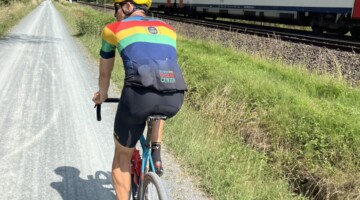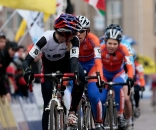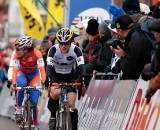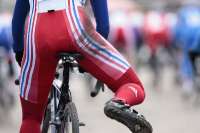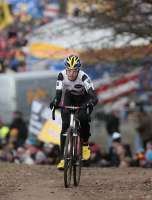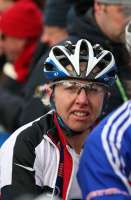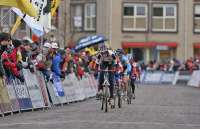Dan Seaton, author of Issue 5’s article on amateur racing in Belgium, takes a deeper look at the 2009 Cyclocross World Championships. Next up is his look at the women’s race. Also see our archive of our live coverage of the race and Dan’s previous look at the men’s race is here.
For a few minutes on the morning of the race we had a chance to talk to most of the U.S. women’s team, who were warming up together in the USA Cycling tents in the team area. From their places on the trainers they told us they were very optimistic about the team’s chances. Laura Van Gilder told us that they thought there was a real chance to get three riders in the top five. “I think that’s so exciting and it’s very motivating for all of us to support all these girls. I think the bar has been raised so high, I think these girls are going to do it today,” she said.
Sue Butler agreed, saying just how excited she was to be part of the team as well, and it was clear from everybody that a real sense of camaraderie dominated the team dynamics. At a time when questions were still swirling around whether the Belgians could come together to fend off defending champion Lars Boom (they did) it was clear that no such questions needed to be asked about the willingness of the U.S. women’s team to work together, even if Katie Compton thought teamwork would not be a major factor in the race.
But a willingness to work for one another is subject to the particulars of how the race develops, and a series of events during the first lap conspired to break down the team effort. Sue Butler told us at the race (and again in her race diary) that she struggled to clip in on the line, finally getting going nearly in last position. Georgia Gould, who told us she was really optimistic about her chances before the race, narrowly avoided a large crash in the first turn of the race, missing her chance to make the main chase group along with teammate Rebecca Lloyd. Gould told us that she thought she rode solidly, but riding in windy and fast conditions with little help from other riders, simply couldn’t close the gap to the front group.
Meanwhile, the fast conditions, which might have dictated team tactics, proved a disappointment for many of the women’s racers, who, coming from a mountain bike background, would have preferred a muddier course. “When it’s slow and just a slog, I think that, for me, right now, it’s easier for me to do well,” said Gould. Lloyd shared her sentiments, “This course just wasn’t technical,” she said. Lloyd told us that the conditions and long finishing stretch led to a more tactical race than she would have preferred.
For many Americans, who sometimes view the presence of actual road in a cyclocross race as sacrilege, the amount of pavement included in the course may have been a surprise. However, it was only a little more than is typical in many European races, where pavement is often viewed as simply another surface on which racers must be prepared to ride.
But third place finisher Katie Compton, known for excelling in bad conditions, said she didn’t mind the fast course. “It’s funny,” she told reporters, “I only ride mud when I’m in Europe. So this is a course that I ride at home quite a bit. So I do like fast courses.” She did, however, admit that she missed the barriers, which were absent from a world championship course for the second year in a row. First-place finisher Marianne Vos was obviously happy with the course and her finishing position, and did not agree. When asked if she missed the barriers in a press conference after the race, Vos gave a one word answer. “No,” she said.
Also see our post-race look at the men’s race.
Photo Gallery:


